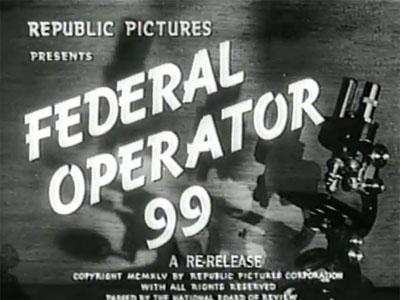
Republic, 1945, 12 Chapters. Starring Marten Lamont, Helen Talbot, George J. Lewis, Lorna Grey, Hal Taliaferro.
As Federal Operator 99 begins, master criminal Jim Belmont (George J. Lewis) is being transported to the West Coast via train to stand trial on several capital charges. However, with the help of his henchman Farrell (Hal Taliaferro), he makes a smooth escape and picks up his sinister career where he left off. His “daring and spectacular crimes” are soon hampered by Federal Operator Jerry Blake (Marten Lamont), who takes over for the Federal agent wounded during Belmont’s escape and continually frustrates Belmont’s plans–although he always misses capturing the mastermind himself, until the showdown in the final chapter.
Federal Operator 99 follows the same basic plot structure as Republic’s earlier Dick Tracy serials–featuring as it does a G-man hero who thwarts a series of unrelated capers while trying to nail the villain responsible for them. Operator lacks the extensive location shooting that so enlivened the potentially repetitious storylines of the Tracy serials, but avoids the curse of repetitiveness through skillful execution in other areas.
Federal Operator 99 was one of the first Republic serials to cut its chapters’ running times to thirteen minutes each. This streamlining gave some mid-1940s Republic serial a rather abridged feel, but it works to Operator’s advantage; since each short chapter devotes a share of its running time to the set-up and execution of Belmont’s crimes and Blake’s counter-moves, director Spencer Bennet’s typically elaborate fistfights don’t dominate the serial to the point of predictability as much as they do in other 1940s Republic outings.
That’s not to say that the fights aren’t suitably set-smashing; among the standouts are the fight in the cave in Chapter Two, the battle in the airplane factory in Chapter Four, the brawl at lawyer Forrest Taylor’s home in Chapter Seven, and the climactic chase-fight in the abandoned theater in the final episode. Some of the best non-slugfest action scenes include the car-motorcyle chase that follows the cave fight in Chapter Two and the well-staged shootout at the garage in Chapter Seven.
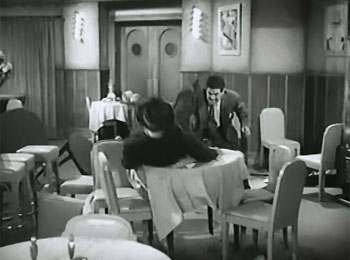
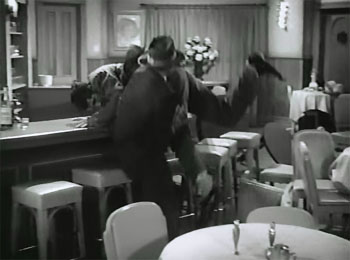
Above: Dale Van Sickel (doubling Marten Lamont) and Fred Graham tear apart a nightclub in another good fight scene from Chapter Five.
The principal stuntwork in these and other scenes is largely handled by Dale Van Sickel (who doubles Marten Lamont), Tom Steele (who stands in for Hal Taliaferro), and Duke Green (who doubles George J. Lewis). Fred Graham and Ken Terrell are also on hand as one-shot thugs who take part in some big fights, while Steele, Van Sickel, and Green appear in acting bits as well. Directorial credit goes not only to Bennet but to collaborators Yakima Canutt and Wallace Grissell, who also worked well with him on Manhunt of Mystery Island.
Writers Basil Dickey, Albert DeMond, Jesse Duffy, and Joseph Poland probably include a few too many scenes of Belmont playing the piano (which wouldn’t actually be a problem if he’d play something other than Beethoven’s Moonlight Sonata), but otherwise reduce redundancy by making each of Belmont’s capers (a jewel robbery, a payroll robbery, espionage, a violin theft) as distinctive as possible. This distinctiveness also carries over to most of the serial’s chapter endings–a few of the highlights being the gas-station explosion at the end of Chapter One (featuring a Lydecker Brothers miniature that would be reused in many later Republics), heroine Helen Talbot’s near-destruction in a unique incineration chamber at the end of Chapter Three, and hero Marten Lamont being knocked off the side of a many-storied garage by a car driven through the wall (courtesy of another good Lydecker miniature) at the end of Chapter Seven.
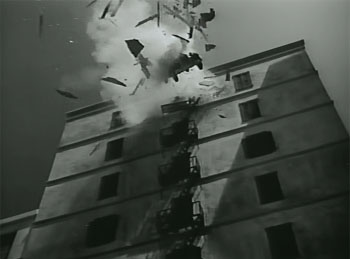
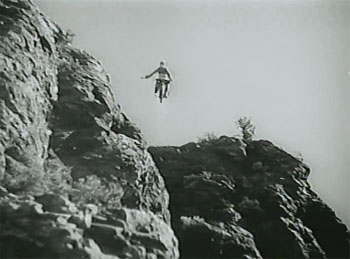
Above: The garage cliffhanger, with the car sailing through the air, at left. At right, our hero and his motorcycle take an apparently fatal plunge from a cliff (this chapter ending, like the aforementioned gas station one, was often reused in later Republics).
Marten Lamont is properly determined in the serial’s lead role; his British accent and polite but serious manner make him seem a bit aloof at times, but also help to make his Blake seem more driven than the average serial G-men; his sober frustration at Belmont’s repeated escapes is very convincing. Articulate and thoughtful-sounding, Lamont is also able to carry off the super-detective aspects of his role better than many serial stars would have.
George J. Lewis is excellent as the sophisticated and music-loving Jim Belmont, one of the most colorful non-masked serial villains; he plays the character as smug and rather condescending, and does a fine job delivering Belmont’s many cynically witty lines. His quiet, dispassionate manner makes Belmont seem more frightening than many an ordinarily bad-tempered heavy, particularly when the character is coldly playing the piano while his followers torture a prisoner.
Helen Talbot is incredibly cute as Lamont’s trusty secretary and all-around helper, although she frankly seems too young and ingenuous to be a Federal operative; one has to question our hero’s wisdom in letting this sweet young thing tail Belmont’s ruthless girlfriend Rita Parker unaided in one chapter. Lorna Gray, who plays Rita, manages to be memorably nasty despite her considerable attractiveness; her breezy, somewhat lowbrow manner also provides an occasional humorous contrast with George Lewis’s refined Belmont.

Above: George J. Lewis (far right) enjoys himself by confusing Hal Taliaferro and Lorna Gray.
Hal Taliaferro also contrasts nicely with his urbane boss; his puzzled reaction when Lewis pauses to hear the end of a broadcast symphony during the escape in Chapter One is particularly funny. Taliaferro handles his grimmer villainous duties with swaggering enthusiasm, although his marked Western drawl always sounds a little out-of-place coming from an urban heavy. LeRoy Mason, though billed high in the credits, only has a few scenes as Belmont’s other lieutenant. William Stevens, as Marten Lamont’s secondary assistant, similarly has little to do; considering Stevens’ flat delivery in his few scenes, it’s probably just as well that his part is small.
Federal Operator 99 has more character-acting vignettes than other Republics of the period. Real-life conductor Jack George plays a self-important pianist and Maurice Cass an eccentric violinist, while the perpetually apoplectic-looking Frank Jacquet pops up as a pompous lawyer and Tom London plays a put-upon professor. Jay Novello has a brief bit as a crooked jeweler, Elaine Lange is a kidnapped Countess, and Stanley Price gets a rare sympathetic role as a reformed member of Belmont’s gang. Ernie Adams appears as a shifty photographer, Edmund Cobb as a cop, and Jack Ingram, Rex Lease, and George Chesebro as henchmen. Forrest Taylor, however, is the most memorable of all the minor players, as a wheelchair-bound shyster who coolly bargains with Belmont over a hidden bullion cache despite his decidedly disadvantaged position.
Federal Operator 99 may feature a standard cops-and-robbers storyline, but that storyline is nicely enhanced by the serial’s memorable heavy, its well-paced script, and its strong action (particularly when it comes to cliffhanger sequences). Throw in an appealing cast, and you have a serial that, while less colorful than many other Republic serials from the 1940s, is easily as entertaining as most of them.
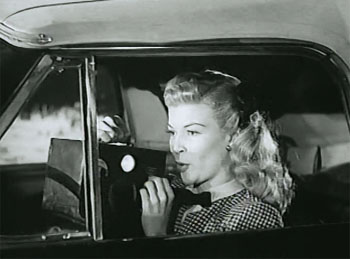
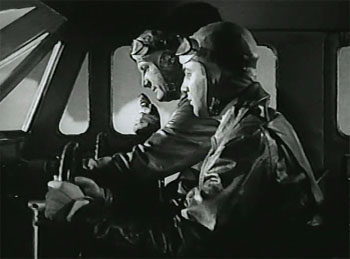
Above: Marten Lamont (on the mike in the right-hand picture) answering Helen Talbot’s radio call for Federal Operator 99.
I just recently watched this for the first time, and it’s absolutely an under-appreciated gem. Fast paced and entertaining throughout, I totally enjoyed it from start to finish. There were plenty of interesting twists and turns, and more than a few great action sequences, along with many nice performances from a varied cast. The body count, and the overall level of violence (both real and implied) surprised me a little, but I suppose it fit the mood of the times, and delivered a measure of realism that the audience found more believable. Some of the “into the camera” action shots almost seemed to prefigure the coming of 3D in the early 1950’s.
The cast was uniformly good, with George J. Lewis certainly making the most of his main villain role. Helen Talbot was definitely cute, but it was Lorna Gray that really caught my eye. She looked terrific, and played the role of Belmont’s accomplice to great effect.
One question: your caption accompanying the screenshot of “over the cliff” motorcycle plunge seems to imply that the stunt was created for this serial and then reused in later productions. The scene just looks so familiar to me, and I’d swear that it was taken from an earlier film, but I can’t say from where. Just my imagination?